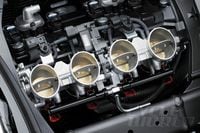Question: Back in the "old" days, streamlining the butterfly valves in carburetors supposedly was important to help maximize the intake efficiency of high-performance engines. All the modern fuel-injected motorcycle engines I've seen, however, use butterfly valves made of thick brass, with large shafts and protruding screwheads. What gives? And why brass?
Frank Jenkins
Menlo Park, California
Answer: There are a couple of things going on here. One is that most fancier (i.e., higher-priced, racing-intended) fuel-injection systems do use tapered, lens-shaped throttle plates whose surfaces are not interrupted by big brass screws. Another is that when injection was adopted, there was no longer a need for a venturi anywhere in the system; instead, metering information is stored in software and no longer "measured" as a venturi pressure. Consequently, the intake-port diameter upstream of the cylinder head is made very large to minimize flow loss; and in such a large port, the butterfly offers much less of a flow disturbance than it would in a smaller port with faster-moving airflow passing over it. That being the case, production fuel-injection systems can use inexpensive, less-aerodynamic components of the kind that you describe.
Brass, meanwhile, has been used in carburetors for years for the same reason it was so common in the navies of the world: It is naturally corrosion-resistant. Water is a product of combustion, so at the particular rpm at which the exhaust system blows back through the intake somewhat on valve overlap, parts in the intake stream will get wet. Anyone who has serviced carbureted bikes after a period of storage will have seen such effects first-hand.
Send your “Ask Kevin” questions to cwservice@cycleworld.com. We cannot guarantee a reply to every inquiry.












/cloudfront-us-east-1.images.arcpublishing.com/octane/EFFSPCZVBBCMTNGVEQMB7NNKIU.jpg)
/cloudfront-us-east-1.images.arcpublishing.com/octane/5GP3PUGFKVGUVCEYG4ZBDYLNBE.jpg)
/cloudfront-us-east-1.images.arcpublishing.com/octane/USTSFGXT3ZGL7BT7B66WMSSKTI.jpg)
/cloudfront-us-east-1.images.arcpublishing.com/octane/Z7YU6FSR6NEKVMKT5CZPMKIVLE.jpg)
/cloudfront-us-east-1.images.arcpublishing.com/octane/MOP35BTV3FFANFBUJKU2RJRTZ4.jpg)
/cloudfront-us-east-1.images.arcpublishing.com/octane/UWTN4NTIJFD25MPXBOVS4DFOXE.jpg)
/cloudfront-us-east-1.images.arcpublishing.com/octane/SIFOY54XMFGEHAUYNFUYVW7IZ4.jpg)
/cloudfront-us-east-1.images.arcpublishing.com/octane/HMC5X3JZHRASXGVCVNBJBWWGSI.jpg)
/cloudfront-us-east-1.images.arcpublishing.com/octane/UIWGXRZDM5HZXJOWXET2DZIWJE.jpg)
/cloudfront-us-east-1.images.arcpublishing.com/octane/QSS5DZ6SKJEU3AKE4KDAWYBEFY.jpg)
/cloudfront-us-east-1.images.arcpublishing.com/octane/SMCEQCLWRVEFTJJES6TAHB3OOQ.jpg)
/cloudfront-us-east-1.images.arcpublishing.com/octane/JCACIDCAC5FUNPTXO2BOUHGGII.jpg)
/cloudfront-us-east-1.images.arcpublishing.com/octane/DC7ZGILA2BCJXHZIUNYGV7JSEA.jpg)
/cloudfront-us-east-1.images.arcpublishing.com/octane/EWJEZUGWEZGABDEQWB64WL46GQ.jpg)
/cloudfront-us-east-1.images.arcpublishing.com/octane/5NHBMRMSFVD5JAPFNMBMNPGXQE.jpg)
/cloudfront-us-east-1.images.arcpublishing.com/octane/WHE43SCPLJBRNANAJAGXHOAIEU.jpg)
/cloudfront-us-east-1.images.arcpublishing.com/octane/6R56AQAW6NDE7BBIJ3SMCOOY5A.jpg)
/cloudfront-us-east-1.images.arcpublishing.com/octane/JMQTUE2FKZFURJTJXDMM4V47AQ.jpg)
/cloudfront-us-east-1.images.arcpublishing.com/octane/P2QYJDMQNVEANMQFXHNB3OVFKQ.jpg)
/cloudfront-us-east-1.images.arcpublishing.com/octane/VNKGXM4AA5BPRGERJOPV6GADAQ.jpg)
/cloudfront-us-east-1.images.arcpublishing.com/octane/2WS4YIFLTNG25L25WP7ZFLSWJM.jpg)
/cloudfront-us-east-1.images.arcpublishing.com/octane/UXRS6ZVQZFC23FY2EDYNT5WMVA.jpg)
/cloudfront-us-east-1.images.arcpublishing.com/octane/7JETMCKNVRGDZIGB3JCITGLPUU.jpg)
/cloudfront-us-east-1.images.arcpublishing.com/octane/OZV6E2KNIJDVHGOKXQQ2AHKLHQ.jpg)